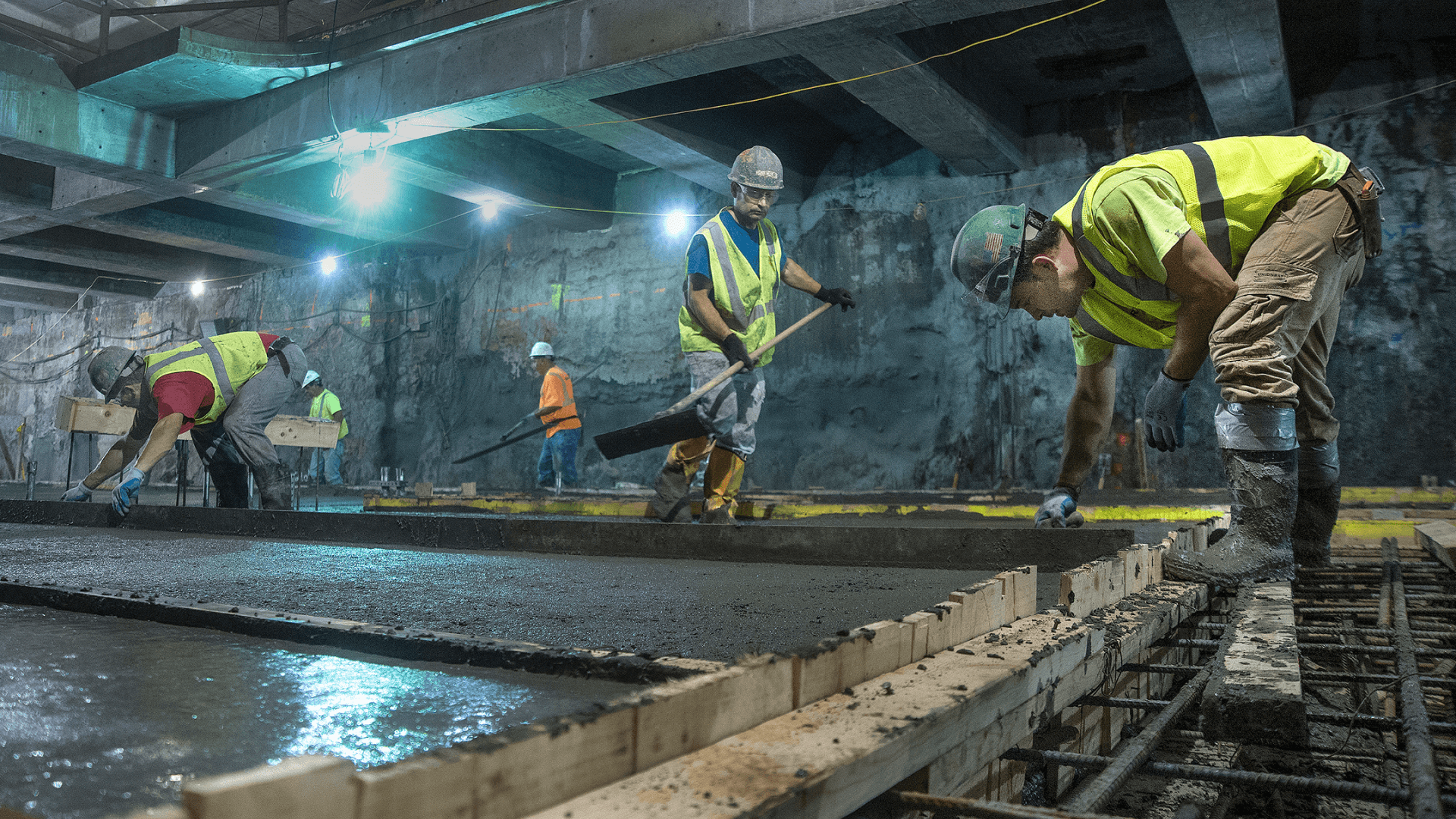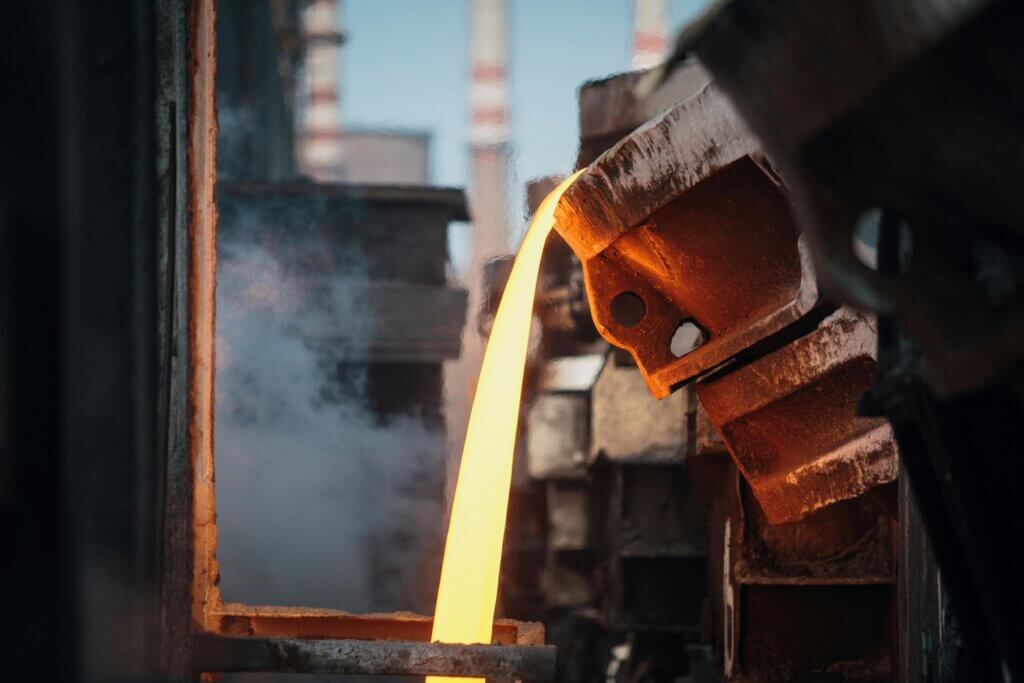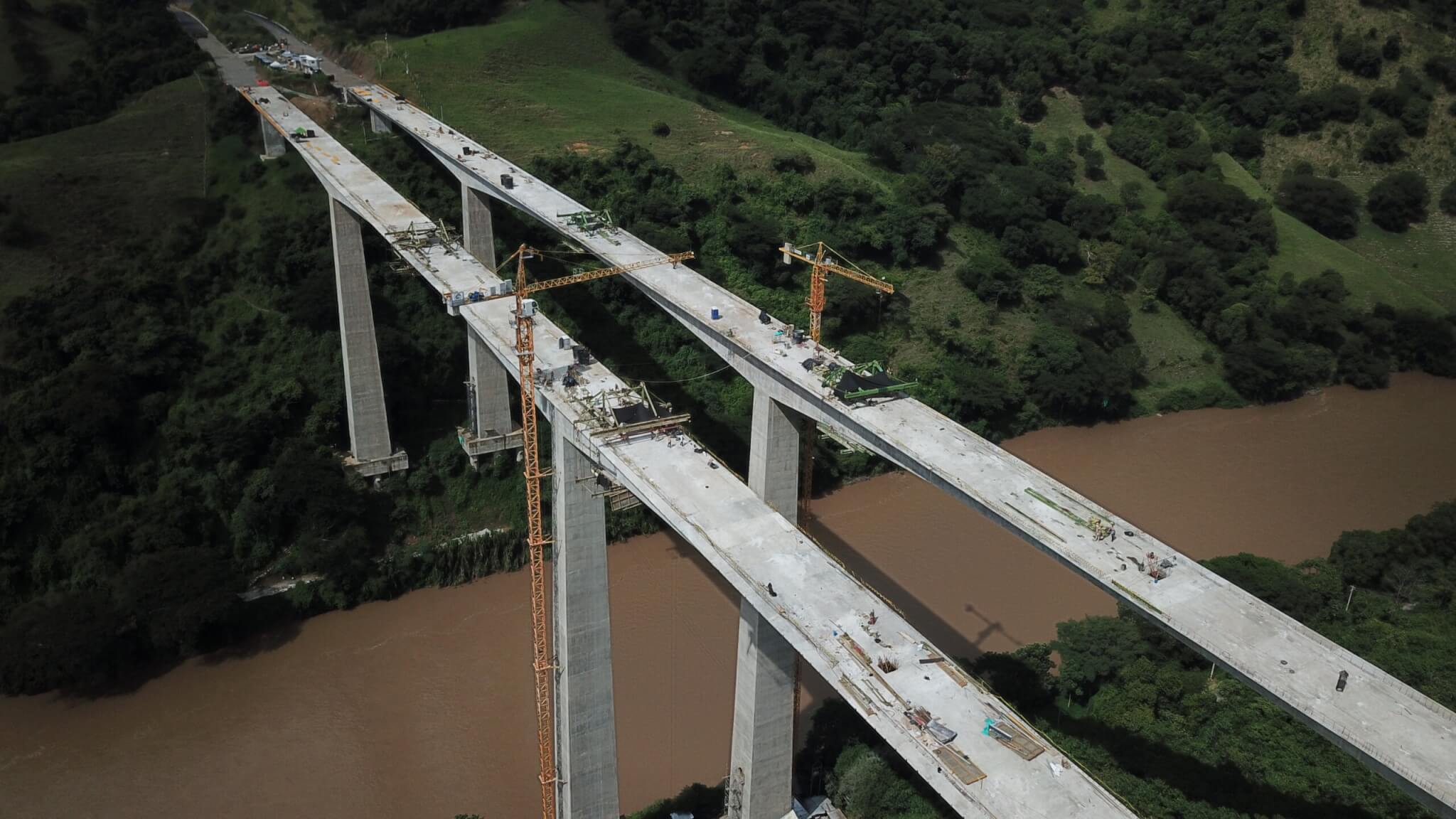
Researchers are developing promising solutions to concrete’s high greenhouse gas emissions — one is ready to scale.
Concrete — a mixture of cement, sand, and gravel — is an essential and affordable material for buildings and infrastructure around the world. Globally, 4.2 billion tons of concrete are produced annually, and demand is expected to increase by 48% by 2050. Concrete is also responsible for 8% of global carbon emissions, making it a major driver of climate change. Simultaneously, however, a warming planet increases the need for concrete to create safe, resilient homes and infrastructure. Concrete is not going anywhere soon — which makes improving its sustainability all the more urgent.
To understand the potential opportunities for emissions reductions, it is helpful first to consider how cement is produced. The process starts with quarrying limestone rocks, sand, and clay, which are blended into a fine powder. Next, the powder is heated to high temperatures in a kiln to calcify limestone into lime, producing clinker. (This chemical process emits a large amount of carbon dioxide.) The clinker is mixed with gypsum and ground into a powder to create cement. The cement is then added to sand and gravel and mixed with water to produce concrete.
The process of producing clinker in cement is responsible for 90% of carbon emissions from concrete. Effective emissions reductions for concrete are possible by either reducing the clinker content in cement or changing the material content within the clinker.
Researchers worldwide have been working hard to reduce emissions by creating material and design efficiencies in planning for new infrastructure, decarbonizing electricity, and enhancing efficiency in cement production. Here are three key emerging technologies that could help solve the emissions challenges associated with concrete.
Going low-carbon: Limestone calcined clay cement (LC3)

Year invented: 2005
Country invented: Switzerland
Potential CO2 reductions: Concrete emissions reduction by 40% and savings of around 500 million tons of CO2 annually by 2030
The potential of the technology: Projected to account for more than one-quarter of cement used globally by 2050
In 2004, Karen Scrivener, the leading chemist on cement decarbonization and a professor at École Polytechnique Fédérale de Lausanne (EPFL) in Switzerland, and Fernando Martirena, a professor at Universidad Central de las Villas (UCLV) in Cuba, first discussed the use of calcined clays as a supplementary cementitious material (SCM) in cement. SCMs are materials added to concrete to enhance cement’s properties, lower its environmental impact, and reduce cement’s clinker content. In 2014, EPFL headed the first three-year phase of the LC3 project with support from UCLV and IIT Delhi. Since then, a growing number of projects have used limestone calcined clay to reduce the amount of clinker in cement.
Limestone calcined clay (LC3) is a mixture of clinker, calcined clays, limestone, and gypsum. Because of savings in energy and materials, LC3 is up to 25% more cost-effective than portland cement, the typical cement used everywhere. Research done by EPFL found that clay reserves are available and abundant worldwide. Unlike many proposed solutions, calcined clays can use existing equipment, offer adequate mechanical qualities, and are globally scalable..
The Cementos Argos plant in Rioclaro, Colombia, is the first large-scale calcined clay production facility and began operations in 2020. The clay is mined 10 miles away and processed in a newly built kiln. This new process has allowed a 30% cut in energy consumption and reduced the facility’s carbon output by half. The switch to LC3 did not slow cement production, as the facility can produce 1.4 megatons of LC3 a year.
In 2022, CBI Ghana signed an $80-million contract to construct the world’s largest calcined clay cement plant, which will substitute 30% to 40% of clinker and reduce carbon emissions from concrete by 40%. Moreover, the use of LC3 blocks will decrease the use of firebricks which are high in embodied carbon.
Even though LC3 is a cost-effective and energy-efficient substitute for traditional portland cement, some scalability barriers need to be overcome. Portland cement is a well-established technology that has been used for generations and is widely produced. Some cement companies are less open to changing how they produce cement and do not want to release capital to invest in new technologies to retrofit their factories. Scaling LC3 cement requires incentives and policies that help promote low-carbon cement production. In some jurisdictions, the use of LC3 cement may require updated standards and codes. Clay can be calcined in standard kilns, but some modifications are required in existing plants.
Nonetheless, there are significant opportunities for progress. Cement production is quickly growing in emerging economies, necessitating new cement plants that can be readily designed to make LC3 from the start. To better take advantage of LC3’s low-carbon benefits, it is essential to start building a market.
Bio-cement: Algae-grown limestone

Year invented: 2020
Country invented: United States
Potential CO2 reductions: Save 2 gigatons of CO2 and pull 250 tons of CO2 from the atmosphere
The potential of the technology: Estimated to grow between 25 and 50 tons of limestone per acre
In 2017, Wil Srubar, a professor at the University of Colorado Boulder, came up with the idea to explore how to grow limestone particles using microalgae during a snorkeling trip in Thailand. Srubar’s team has found that replacing limestone with algae-grown limestone out of coccolithophores — microalgae that sequester and store carbon dioxide in mineral form through photosynthesis — creates a net carbon-neutral and carbon-negative way to produce portland cement.
Coccolithophores are incredibly resilient and can live in salt water or fresh water and at high or low temperatures. The researchers see biogenic cement as a plug-and-play material that can be used in the traditional cement process.
The Colorado-based company Prometheus Materials utilizes algae to produce masonry blocks that achieved ASTM C129-22, Standard Specification for Nonloadbearing Concrete Masonry Units, and C90, Standard Specification for Loadbearing Concrete Masonry Units performance requirements. The blocks are also lighter, have a compressive strength that rivals traditional concrete, and reduce thermal transmission.
While algae-grown limestone has been demonstrated at a small scale, there are barriers. The primary issue with biogenic cement involves scaling it up affordably and then demonstrating its use in large-scale projects. The technology is also relatively new in its development and has a low Technical Readiness Level (TRL) and Adoption Readiness Level (ARL). This means that more evaluations are required before using the cement in the projects and scaling them to achieve significant reductions in greenhouse gas emissions.
Electric recycled cement

Year invented: 2022
Country invented: England
Potential CO2 reductions: 2 gigatons of CO2
The potential of the technology: Produce 1 billion tons annually by 2050
The inspiration for electric cement came to the University of Cambridge’s Dr. Cyrille Dunant during Covid-19 when he noticed that the chemistry of recycled cement was nearly identical to lime-flux used in steel recycling processes. Cambridge researchers believe the key to reducing clinker emissions is heating recycled cement in electric arc furnaces (EAFs). Concrete is crushed until cement separates from the aggregates and is then taken to an EAF to use in place of lime as a “flux” (a cleaning agent that removes impurities from molten metal). As the steel melts, the flux forms a slag that is similar to portland cement when cooled and ground up.
Researchers believe electric recycled cement will have the same durability as traditional cement due to its similar composition. The cement provides cost-savings because it uses existing steel production equipment that researchers believe can be scaled rapidly. The cement can also potentially be carbon neutral because emissions have already occurred through the original concrete production and if the EAFs are powered by renewable energy.
Celsa Group, a multinational group of steel companies, replicated this process at scale in its EAFs in Cardiff, known as the Cement 2 Zero project. The trials include 12 induction furnace trials and 8 trials in the Institute’s 7-ton EAF. The company and researchers hope the method will produce up to 30 tons of recycled cement per hour.
Some issues that have come up with this process are that the equipment needs reliable renewable energy inputs, and a supply chain needs to be developed. Two other crucial issues involve sourcing sufficient quantities of concrete waste and reaching the required temperature to produce the cement, which is much higher than the usual temperature in a cement kiln. The technology is also relatively new and has a low Technical Readiness Level and Adoption Readiness Level, meaning more evaluations must be done before using the cement in current projects and scaling to a degree where there is a significant impact on greenhouse gas reduction.
Notable startup companies working on low-carbon cement
These emerging methods and technologies are only some of the new ways researchers and industry experts are finding solutions to reduce concrete emissions — and more efforts are emerging. For example, companies like Sublime, Fortera, and Brimstone are using novel chemistries to change the chemical reaction used to create cement.
Sublime, based in Massachusetts, turns limestone into lime through an electrolytic process, which involves using an electric current to change a substance. Sublime’s technology can be fueled by renewable energy and the process allows for cement’s ingredients to be broken down at room temperature. A small quantity of the cement was used on One Boston Wharf, where it was mixed in a ready-mix concrete truck, maintained workability, and poured out of the concrete truck. Sublime plans to open a demonstration plant in early 2026 in Holyoke, Massachusetts, where it will produce 30,000 tons of clean cement per year.
Based in California, Fortera uses a technology that works within existing cement facilities. The technology takes the carbon released by the kilns and routes it back into the process to make additional cement by mixing the CO2 with calcium oxide to make ReAct Cement™. Fortera has opened its first demonstration plant in Redding, California, where it will capture 6,600 tons of CO2 and produce 15,000 tons of low-carbon ReAct Cement™. There will also be a 70% reduction of carbon emissions on a ton-for-ton basis, and the process will eliminate the feedstock waste associated with traditional concrete production.
Brimstone, based in California, uses calcium silicate rock instead of limestone to create a different chemical reaction without CO2 emissions. Instead of heating limestone to create lime, the company extracts calcium oxide from the rock — which does not release CO2. While these processes are different, the cement produced is chemically and physically identical to traditional cement. Brimstone’s first plant will produce up to a combined 140,000 metric tons per year of Ordinary Portland Cement and SCMs. The plant will also prevent 120,000 metric tons of CO2 emissions annually.
Brimstone and Sublime have recently been selected for award negotiations under the Department of Energy’s Industrial Demonstration Program and are starting to make waves in the construction industry. These grants will help these new companies scale up and build their first commercial-scale plants. Getting to scale is essential to reducing costs and making low-carbon cement commercially viable.
Reducing carbon emissions within the cement and concrete industry has become a top priority for researchers, innovative owners and developers, architects, engineers, and leading cement and concrete companies. While these emerging technologies are great steps forward, it is time to accelerate an effective transformation of the concrete industry. It is essential to collaborate across sectors and deploy a fuller range of strategies — including material and design efficiencies, decarbonizing electricity, and efficiency in cement and concrete production — to reduce emissions.
Tharika Lecamwasam is a 2024 summer intern for ClimateWorks’ Industry program, where she researched low-carbon cement technologies that can reduce greenhouse gas emissions in the concrete industry. She is currently a senior at the University of Massachusetts Amherst majoring in Sustainable Community Development with a concentration in the Built Environment. She minors in Information Technology and will receive a certificate in Integrated Concentration in STEM.

